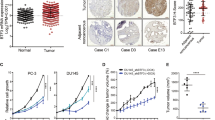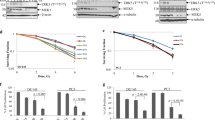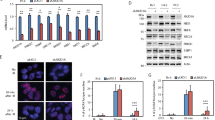Abstract
In this study, we investigated the functional role of early growth response-1 (Egr1 gene) in the regulation of radiation-induced clonogenic inhibition and apoptosis in p53 wild-type and mutant prostate cancer cells 22Rv1 and DU145, respectively. 22Rv1 cells were more sensitive to irradiation compared with DU145 cells, and the sensitivity was enhanced by overexpression of EGR-1 in both cells. Dominant-negative EGR-1 mutant (dnEGR-1) or repressor of EGR-1, NGFIA binding protein 1 (NAB1), increased radioresistance of these cells. Significant activation of caspases 3 and 9 and Bcl2-associated X (Bax) with increased poly(ADP-ribose) polymerase (PARP) cleavage and cytochrome c release was observed in radiation-exposed EGR-1 overexpressing cells. Gel shift analysis and chloramphenicol acetyl transferase (CAT) reporter assays indicate that EGR-1 transactivates the promoter of the Bax gene. Interaction of EGR-1 and Yes kinase-associated protein 1 (YAP-1) through the WW domain of YAP-1 enhances the transcriptional activity of EGR-1 on the Bax promoter as shown by chromatin immunoprecipitation and reporter assays. Irradiation of PC3 cell xenografts that were treated with adenoviral EGR-1 showed significant regression in tumor volume. These findings establish the radiation-induced pro-apoptotic action of EGR-1, in a p53-independent manner, by directly transactivating Bax, and prove that alters the B-cell CLL/lymphoma 2 (Bcl-2)/Bax ratio as one of the mechanisms resulting in significant activation of caspases, leading to cell death through the novel interaction of EGR-1 with YAP-1.
This is a preview of subscription content, access via your institution
Access options
Subscribe to this journal
Receive 50 print issues and online access
$259.00 per year
only $5.18 per issue
Buy this article
- Purchase on Springer Link
- Instant access to full article PDF
Prices may be subject to local taxes which are calculated during checkout






Similar content being viewed by others
References
Abdulkadir SA, Carbone JM, Naughton CK, Humphrey PA, Catalona WJ, Milbrandt J . (2001a). Frequent and early loss of the EGR1 corepressor NAB2 in human prostate carcinoma. Hum Pathol 32: 935–939.
Abdulkadir SA, Qu Z, Garabedian E, Song SK, Peters TJ, Svaren J et al. (2001b). Impaired prostate tumorigenesis in Egr1-deficient mice. Nat Med 7: 101–107.
Ahmed MM, Sells SF, Venkatasubbarao K, Fruitwala SM, Muthukkumar S, Harp C et al. (1997). Ionizing radiation-inducible apoptosis in the absence of p53 linked to transcription factor EGR-1. J Biol Chem 272: 33056–33061.
Ahmed MM, Venkatasubbarao K, Fruitwala SM, Muthukkumar S, Wood Jr DP, Sells SF et al. (1996). EGR-1 induction is required for maximal radiosensitivity in A375-C6 melanoma cells. J Biol Chem 271: 29231–29237.
Antonsson B, Montessuit S, Sanchez B, Martinou JC . (2001) Bax is present as a high molecular weight oligomer/complex in the mitochondrial membrane of apoptotic cells. J Biol Chem 276: 11615–11623.
Basu S, Totty NF, Irwin MS, Sudol M, Downward J . (2003). Akt phosphorylates the Yes-associated protein, YAP, to induce interaction with 14-3-3 and attenuation of p73-mediated apoptosis. Mol Cell 11: 11–23.
Buttyan R, Zakeri Z, Lockshin R, Wolgemuth D . (1988). Cascade induction of c-fos, c-myc, and heat shock 70K transcripts during regression of the rat ventral prostate gland. Mol Endocrinol 2: 650–657.
Das A, Chendil D, Dey S, Mohiuddin M, Mohiuddin M, Milbrandt J et al. (2001). Ionizing radiation down-regulates p53 protein in primary Egr-1−/− mouse embryonic fibroblast cells causing enhanced resistance to apoptosis. J Biol Chem 276: 3279–3286.
Datta R, Rubin E, Sukhatme V, Qureshi S, Hallahan D, Weichselbaum RR et al. (1992). Ionizing radiation activates transcription of the EGR1 gene via CArG elements. Proc Natl Acad Sci USA 89: 10149–10153.
Day ML, Wu S, Basler JW . (1993). Prostatic nerve growth factor inducible A gene binds a novel element in the retinoblastoma gene promoter. Cancer Res 53: 5597–5599.
Dong J, Feldmann G, Huang J, Wu S, Zhang N, Comerford SA et al. (2007). Elucidation of a universal size-control mechanism in Drosophila and mammals. Cell 130: 1120–1133.
Eid MA, Kumar MV, Iczkowski KA, Bostwick DG, Tindall DJ . (1998). Expression of early growth response genes in human prostate cancer. Cancer Res 58: 2461–2468.
Espejo A, Bedford MT . (2004). Protein-domain microarrays. Methods Mol Biol 264: 173–181.
Kalkhoven E . (2004). CBP and p300: HATs for different occasions. Biochem Pharmacol 68: 1145–1155.
Kyprianou N . (1994). Apoptosis: therapeutic significance in the treatment of androgen-dependent and androgen-independent prostate cancer. World J Urol 12: 299–303.
Lee JM, Bernstein A . (1993). p53 mutations increase resistance to ionizing radiation. Proc Natl Acad Sci USA 90: 5742–5746.
Macias MJ, Wiesner S, Sudol M . (2002). WW and SH3 domains, two different scaffolds to recognize proline-rich ligands. FEBS Lett 513: 30–37.
Matallanas D, Romano D, Yee K, Meissl K, Kucerova L, Piazzolla D et al. (2007). RASSF1A elicits apoptosis through an MST2 pathway directing proapoptotic transcription by the p73 tumor suppressor protein. Mol Cell 27: 962–975.
Matheny C, Day ML, Milbrandt J . (1994). The nuclear localization signal of NGFI-A is located within the zinc finger DNA binding domain. J Biol Chem 269: 8176–8181.
Nair P, Muthukkumar S, Sells SF, Han SS, Sukhatme VP, Rangnekar VM . (1997). Early growth response-1-dependent apoptosis is mediated by p53. J Biol Chem 272: 20131–20138.
Oka T, Mazack V, Sudol M . (2008). Mst2 and Lats kinases regulate apoptotic function of Yes kinase-associated protein (YAP). J Biol Chem 283: 27534–27546.
Shareef MM, Cui N, Burikhanov R, Gupta S, Satishkumar S, Shajahan S et al. (2007). Role of tumor necrosis factor-alpha and TRAIL in high-dose radiation-induced bystander signaling in lung adenocarcinoma. Cancer Res 67: 11811–11820.
Strano S, Blandino G . (2007). YAP1 meets tumor suppression. Mol Cell 27: 863–864.
Sudol M . (1994). Yes-associated protein (YAP65) is a proline-rich phosphoprotein that binds to the SH3 domain of the Yes proto-oncogene product. Oncogene 9: 2145–2152.
Sudol M, Bork P, Einbond A, Kastury K, Druck T, Negrini M et al. (1995). Characterization of the mammalian YAP (Yes-associated protein) gene and its role in defining a novel protein module, the WW domain. J Biol Chem 270: 14733–14741.
Svaren J, Ehrig T, Abdulkadir SA, Ehrengruber MU, Watson MA, Milbrandt J . (2000). EGR1 target genes in prostate carcinoma cells identified by microarray analysis. J Biol Chem 275: 38524–38531.
Tsujimoto Y . (1998). Role of Bcl-2 family proteins in apoptosis: apoptosomes or mitochondria? Genes Cells 3: 697–707.
Virolle T, Adamson ED, Baron V, Birle D, Mercola D, Mustelin T et al. (2001). The Egr-1 transcription factor directly activates PTEN during irradiation-induced signalling. Nat Cell Biol 3: 1124–1128.
Zender L, Spector MS, Xue W, Flemming P, Cordon-Cardo C, Silke J et al. (2006). Identification and validation of oncogenes in liver cancer using an integrative oncogenomic approach. Cell 125: 1253–1267.
Acknowledgements
This work was supported by grants, NIH (RO1 CA78471), PCRP-DOD (PC 970526) and Charlotte Geyer foundation to MMA; post-doctoral training grant, PCRP-DOD (WB1XWH-04-1-0039) to MZ; NIH (DK62345) and Pennsylvania Department of Health Grant (SAP4100037378) to MMS and Welch Foundation Grant (G-1495) to MTB.
Author information
Authors and Affiliations
Corresponding author
Additional information
Supplementary Information accompanies the paper on the Oncogene website (http://www.nature.com/onc)
Supplementary information
Rights and permissions
About this article
Cite this article
Zagurovskaya, M., Shareef, M., Das, A. et al. EGR-1 forms a complex with YAP-1 and upregulates Bax expression in irradiated prostate carcinoma cells. Oncogene 28, 1121–1131 (2009). https://doi.org/10.1038/onc.2008.461
Received:
Revised:
Accepted:
Published:
Issue Date:
DOI: https://doi.org/10.1038/onc.2008.461
Keywords
This article is cited by
-
New insights into the ambivalent role of YAP/TAZ in human cancers
Journal of Experimental & Clinical Cancer Research (2023)
-
Hippo pathway dysregulation in gastric cancer: from Helicobacter pylori infection to tumor promotion and progression
Cell Death & Disease (2023)
-
Molecular regulation of trophoblast stem cell self-renewal and giant cell differentiation by the Hippo components YAP and LATS1
Stem Cell Research & Therapy (2022)
-
Gone Caving: Roles of the Transcriptional Regulators YAP and TAZ in Skeletal Development
Current Osteoporosis Reports (2020)
-
EGR1 regulates angiogenic and osteoclastogenic factors in prostate cancer and promotes metastasis
Oncogene (2019)



